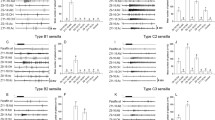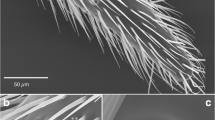Summary
Electroantennographic and single sensillum recordings were performed on male pine sawfly, Neodiprion sertifer, antennae. Responses to the sex pheromone component (2S, 3S, 7S)- 3,7-dimethyl-2-pentadecenyl (diprionyl) acetate (SSS:OAc), to the behavioral inhibitor (2S, 3R, 7R)-diprionyl acetate (SRR:OAc), to the six other enantiomers of diprionyl acetate, and to the biosynthetic precursor diprionol were recorded. Responses to trans-perillenal, a monoterpene identified in female gland extracts and to (2S, 3S, 7S)-diprionyl propionate (SSS:OPr), a field attractant for N. sertifer and some related sawfly species were also recorded.
EAG recordings demonstrated a high antennal sensitivity to SSS:OAc and to SSS:OPr. A somewhat lower response was elicited by SRR:OAc.
Single sensillum recordings revealed 8–12 different cells firing in each sensillum, corresponding to the number of cells observed in earlier morphological investigations. Out of these cells all, except one, responded to SSS:OAc and to SSS:OPr. No differences in the response to the two components could be observed. The largest amplitude cell in each sensillum was specifically tuned to the behavioral antagonist, SRR:OAc. The pheromone perception system encountered in male pine sawflies thus differs clearly from that observed in moths.
Similar content being viewed by others
Abbreviations
- EAG :
-
electroantennogram
- OAc :
-
acetate
- OPr :
-
propionate
References
Ahlgren G, Bergström G, Löfqvist J, Jansson A, and Norin T (1979) trans-perillenal. A furanoid monoterpene from pine saw-fly, Neodiprion sertifer (Hymenoptera: Diprionidae). J Chem Ecol 5:309–319
Baeckström P, Okecha S, De Silva N, Wijekoon D, and Norin T (1982) Photooxidation with simultaneous reduction of hydroperoxides with tetrabutylammonium borohydride. Synthesis of perillenal from myrcene. Acta Chem Scand B36:31–36
Byström S, Högberg HE, and Norin T (1981) (2S, 3S, 7S)-3,7-dimethyl-pentadecan-2-yl acetate and propionate, potential sex pheromone components of the pine sawfly Neodiprion sertifer (Geoffr.). Tetrahedron 37:2249
Coppel HC, Casida JE, and Dauterman WC (1960) Evidence for a potent sex attractant in the introduced pine sawfly, Diprion similis (Hymenoptera: Diprionidae). Ann Entomol Soc Am 53:510–512
Dickens JC, Mori K (1989) Receptor chirality and behavioral specificity of the boll weevil, Anthonomus grandis Boh. (Coleoptera: Curculionidae), for its pheromone, (+)-grandisol. J Chem Ecol 15:517–528
Frérot B, Pougny J-R, Milat M-L, Rollin P, and Malosse C (1988) Étude de la sécrétion phéromonale de Cymbalophora pudica (Esper) et de l'énantiosélectivité de la perception phéromonale. CR Acad Sci Paris 306:157–160
Grant AJ, O'Connell RJ, and Hammond AM (1988) A comparative study of pheromone perception in two species of noctuid moths. J Insect Behav 1:75–95
Hallberg E (1979) The fine structure of the antennal sensilla of the pine saw fly Neodiprion sertifer (Insecta: Hymenoptera). Protoplasma 101:111–126
Hallberg E, Löfqvist J (1981) Morphology and ultrastructure of an intertergal pheromone gland of the pine sawfly Neodiprion sertifer (Insecta: Hymenoptera): a potential source of sex pheromone. Can J Zool 59:47–53
Hansson BS, Löfstedt C, Löfqvist J, and Hallberg E (1986) Spatial arrangement of different types of pheromone-sensitive sensilla in a male moth. Naturwissenschaften 73:269–270
Hansson BS, Löfstedt C, and Roelofs WL (1987) Inheritance of olfactory response to sex pheromone components in Ostrinia nubilalis. Naturwissenschaften 74:497–99
Hansson BS, Löfstedt C, and Foster SP (1989a) Z-linked inheritance of male olfactory response to sex pheromone components in two species of tortricid moths, Ctenopseustis obliquana and Ctenopseustis sp. Entomol Exp Appl 53:137–145
Hansson BS, Van Der Pers JNC, and Löfqvist J (1989b) Comparison of male and female olfactory cell response to pheromone compounds and plant volatiles in the turnip moth, Agrotis segetum. Physiol Entomol 14:147–155
Högberg HE, Hedenström E, Wassgren AB, Hjalmarsson M, Bergström G, Löfqvist J, and Norin T (1990) Synthesis and gas chromatographic separation of the eight stereoisomers of diprionol and their acetates, components of the sex pheromone of pine sawflies. Tetrahedron 46:3007–1018
Jewett DM, Matsumura F, Coppel HC (1976) Sex pheromone specificity in the pine sawfly: Interchange of acid moieties in an ester. Science 192:51–53
Kaissling K-E (1974) Sensory transduction in insect olfactory receptors. In: Jaenicke L (ed) Biochemistry of sensory functions. Springer, Berlin Heidelberg New York, pp 243–273
Kaissling KE (1986) Chemo-electrical transduction in insect olfactory receptors. Annu Rev Neurosci 9:121–145
Keil TA (1989) Fine structure of the pheromone sensitive sensilla on the antenna of the hawkmoth, Manduca sexta. Tissue Cell 21:139–151
Kikukawa T, Matsumura F, Olaifa J, Kraemer M, Coppel HC, Tai A (1983) Field evaluation of chiral isomers of the sex pheromone of the European sawfly, Neodiprion sertifer. J Chem Ecol 9:673–675
Kraemer ME, Coppel HC, Kikukawa T, Matsumura F, Thomas HA, Thompson LC, Mori K (1983) Field electroantennogram responses to sex pheromone optical isomers by four fall flying sawfly species (Hymenoptera: Diprionidae: Neodiprion). Env Entomol 12:1592–1596
Liljefors T, Thelin B, Van der Pers JNC (1984) Structure-activity relationships between stimulus molecule and response of a pheromone receptor cell in turnip moth, Agrotis segetum. Modifications of the acetate group. J Chem Ecol 10:1661–1675
Löfqvist J (1986) Species specificity in response to pheromone substances in diprionid sawflies. In: Payne TL (ed) Mechanisms in insect olfaction. Oxford University Press, Oxford, pp 123–129
Löfstedt C, Van Der Pers JNC, Löfqvist J, Lanne BS, Appelgren M, Bergström G, Thelin B (1982) Sex pheromone components of the turnip moth, Agrotis segetum: Chemical identification, electrophysiological evaluation, and behavioural activity. J Chem Ecol 8:1305–1322
Olaifa JI, Matsumura F, Coppel HC (1987) Field response and gas-liquid chromatograph separation of optically active synthetic and natural pheromones in two sympatric diprionid sawflies, Neodiprion nanulus nanulus and Neodiprion sertifer (Hymenoptera. Diprionidae). J Chem Ecol 13:1395–1408
Payne TL, Richerson JV, Dickens JC, West JR, Mori K, Berisford CW, Hedden RL, Vité JP, Blum MS (1982) Southern pine beetle: Olfactory receptor and behaviour discrimination of enantiomers of the attractant pheromone frontalin. J Chem Ecol 8:873–881
Seabrook WD, Linn CE, Dyer LJ, Shorey HH (1987) Comparison of electroantennograms from female and male cabbage looper moths (Trichoplusia ni) of different ages and for various pheromone concentrations. J Chem Ecol 13:1443–1453
Steinbrecht RA (1987) Functional morphology of pheromone-sensitive sensilla. In: Prestwich GD, Blomquist G (eds) Insect biochemistry. Academic Press, New York, pp 353–383
Van Der Pers JNC (1981) Comparison of electroantennogram response spectra of plant volatiles in seven species of Yponomeuta and in the tortricid Adoxophyes orana. Entomol Exp Appl 30:181–192
Van Der Pers JNC, Den Otter CJ (1978) Single cell responses from olfactory receptors of small ermine moths to sex attractants. J Insect Physiol 24:337–343
Author information
Authors and Affiliations
Rights and permissions
About this article
Cite this article
Hansson, B.S., Van der Pers, J.N.C., Högberg, H.E. et al. Sex pheromone perception in male pine sawflies, Neodiprion sertifer (Hymenoptera; Diprionidae). J Comp Physiol A 168, 533–538 (1991). https://doi.org/10.1007/BF00215075
Accepted:
Issue Date:
DOI: https://doi.org/10.1007/BF00215075




